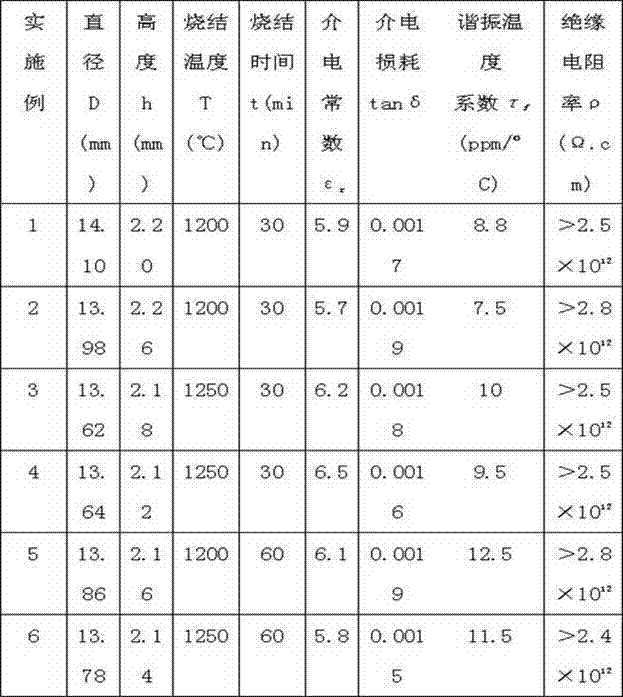Method for preparing intermediate-temperature microwave dielectric ceramic material
A microwave dielectric ceramic, medium-temperature technology, applied in ceramics, inorganic insulators, etc., can solve the problems of high preparation cost, restrict product sales market, etc., and achieve the effects of low microwave dielectric loss, energy-saving preparation method and low price.
- Summary
- Abstract
- Description
- Claims
- Application Information
AI Technical Summary
Problems solved by technology
Method used
Image
Examples
example 1
[0036] Weigh the treated kaolin 91.85% by weight percentage; Modifier MgO, 3%; CaO, 2%; ZnO, 0.5%; B 2 o 3 , 2.5%; SnO 2, 0.15% was added to the ball mill tank, and the planetary ball mill was used to mix and grind for 12 hours. The grinding balls were zirconia balls, and the ball milling medium was absolute ethanol. The mass ratio of grinding balls: material: absolute ethanol was 3:1:1 , the speed of the ball mill is 300rpm. After ball milling for 12 hours, add 5wt% polyvinyl butyral (PVB) binder with a concentration of 10wt%, ball mill for another 1.5 hours, mix evenly, granulate, pass through a 100-mesh sieve, and press into tablets at 16Mpa. Heat at 2°C / min to 500°C for 1 hour for debinding, 3°C / min to 900°C, then 2°C / min to 1200°C for 30 minutes, cool to room temperature with the furnace, and take out the sample Grinding and polishing, using agilent4991A to measure the dielectric constant within the frequency range of 1MHz to 3 GHz is 5.9, the dielectric loss is 0.0017...
example 2
[0038] Weigh the treated kaolin 91.2% by weight percentage; Modifier MgO, 3.5%; CaO, 1.5%; ZnO, 0.6%; B 2 o 3 , 3%; SnO 2 , 0.2% into the ball mill tank, and use a planetary ball mill to mix and grind for 14 hours. The balls are zirconia balls, and the ball milling medium is absolute ethanol. The mass ratio of grinding balls: material: absolute ethanol is 3:1:1.2 , the ball mill rotating speed is 200rpm. After 14 hours of ball milling, add 3wt% polyvinyl butyral (PVB) binder with a concentration of 10%, ball mill for another 2 hours, mix evenly, granulate, pass through a 100-mesh sieve, and press into tablets at 17Mpa. Heat at 2°C / min to 500°C for 2 hours for debinding, rise at 3°C / min to 900°C, then rise to 1200°C at 1°C / min for 30 minutes, cool to room temperature with the furnace, and take out the sample Grinding and polishing, using agilent4991A to measure the dielectric constant within the frequency range of 1MHz to 3GHz is 5.7, the dielectric loss is 0.0019, the tempe...
example 3
[0040] Weigh the treated kaolin 90.6% by weight percentage; Modifier MgO, 2%; CaO, 3%; ZnO, 0.8%; B 2 o 3 , 3.5%; SnO 2 , 0.1% is added in the ball mill tank, and the planetary ball mill is used for 12 hours to mix and grind, the balls are zirconia balls, the ball milling medium is absolute ethanol, and the mass ratio of balls: material: absolute ethanol is 4:1:1.2 , the speed of the ball mill is 300rpm. After ball milling for 12 hours, add 5wt% polyvinyl butyral (PVB) binder with a concentration of 15wt%, ball mill for another 2 hours, mix evenly, granulate, pass through a 100-mesh sieve, and press into tablets at 16Mpa. Heat at 2°C / min to 500°C for 1 hour for debinding, rise at 4°C / min to 900°C, then rise to 1250°C at 2°C / min and hold for 30 minutes, cool to room temperature with the furnace, and take out the sample Grinding and polishing, using agilent4991A to measure the dielectric constant within the frequency range of 1MHz to 3GHz is 6.2, the dielectric loss is 0.0018...
PUM
| Property | Measurement | Unit |
|---|---|---|
| resonant frequency temperature coefficient | aaaaa | aaaaa |
| resonant frequency temperature coefficient | aaaaa | aaaaa |
| resonant frequency temperature coefficient | aaaaa | aaaaa |
Abstract
Description
Claims
Application Information
 Login to View More
Login to View More - R&D
- Intellectual Property
- Life Sciences
- Materials
- Tech Scout
- Unparalleled Data Quality
- Higher Quality Content
- 60% Fewer Hallucinations
Browse by: Latest US Patents, China's latest patents, Technical Efficacy Thesaurus, Application Domain, Technology Topic, Popular Technical Reports.
© 2025 PatSnap. All rights reserved.Legal|Privacy policy|Modern Slavery Act Transparency Statement|Sitemap|About US| Contact US: help@patsnap.com

